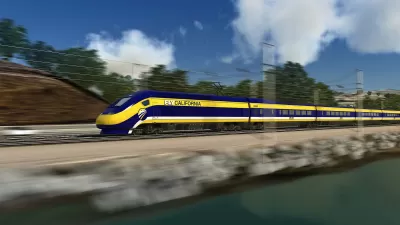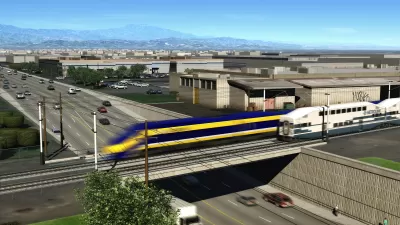In the face of political opposition and mounting construction costs in Southern California, the state High-Speed Rail Authority has chosen to build north from the Central Valley to San Jose rather than south from Fresno to the San Fernando Valley.
To be clear, the "initial operating section" included both the northern and southern sections in 2011. The decision by the California High-Speed Rail Authority to change course and build from Kern County to San Jose will save money and time due to the formidable tunneling costs under the Tehachapi and San Gabriel Mountains and local political opposition in the Palmdale to Burbank section.
"The high-speed rail authority said shifting to the Bay Area will allow it to have the initial segment operating by 2025, earlier than planned, which will make the project attractive to private investors that would help fill holes in funding," write Dan Weikel and Ralph Vartabedian for the Los Angeles Times.
"The math is pretty clear," said Dan Richard, chairman of the board that oversees the project in an AP article. "It’s just longer and more expensive to get to L.A. And looking at the available funds, we just couldn’t get there."
The change of Initial Operating Section was contained in the new Draft 2016 Business Plan [PDF] released Thursday, Feb. 18.
"It’s a major strategic pivot for the rail agency, which in its 2012 and 2014 versions of the business plan had proposed a route from Merced southward through the Valley to Bakersfield, then southeast to Palmdale and on to the San Fernando Valley and Los Angeles," writes Tim Sheehan for The Fresno Bee.
Sheehan goes into the funding numbers in detail for the northern route to San Jose, writing that it "leaves a gap of about $14 billion to get from the Valley over Pacheco Pass to Gilroy and San Jose."
Construction work began over a year ago in Fresno. Last week, the authority appeared in court in Sacramento facing what may be "the most serious challenge to the entire project," write Ralph Vartabedian and Marc Vartabedian.
It is the second lawsuit filed by attorneys for Kings County and two Central Valley farmers that charges that the project "violates state law because it is not financially viable, will operate slower than promised and has compromised its design by using existing shared tracks in the Bay Area." [Outcome of first lawsuit.]
No word on when Judge Michael Kenny will deliver his ruling, but reporters speculated it will take at least a few weeks. "No matter how Kenny eventually rules, it’s a near certainty that whichever side loses will appeal the decision to the state’s court of appeal," writes Sheehan.
FULL STORY: Change in bullet train construction plans will delay rail line's arrival in Southern California

Planetizen Federal Action Tracker
A weekly monitor of how Trump’s orders and actions are impacting planners and planning in America.

Congressman Proposes Bill to Rename DC Metro “Trump Train”
The Make Autorail Great Again Act would withhold federal funding to the system until the Washington Metropolitan Area Transit Authority (WMATA), rebrands as the Washington Metropolitan Authority for Greater Access (WMAGA).

The Simple Legislative Tool Transforming Vacant Downtowns
In California, Michigan and Georgia, an easy win is bringing dollars — and delight — back to city centers.

The States Losing Rural Delivery Rooms at an Alarming Pace
In some states, as few as 9% of rural hospitals still deliver babies. As a result, rising pre-term births, no adequate pre-term care and "harrowing" close calls are a growing reality.

The Small South Asian Republic Going all in on EVs
Thanks to one simple policy change less than five years ago, 65% of new cars in this Himalayan country are now electric.

DC Backpedals on Bike Lane Protection, Swaps Barriers for Paint
Citing aesthetic concerns, the city is removing the concrete barriers and flexposts that once separated Arizona Avenue cyclists from motor vehicles.
Urban Design for Planners 1: Software Tools
This six-course series explores essential urban design concepts using open source software and equips planners with the tools they need to participate fully in the urban design process.
Planning for Universal Design
Learn the tools for implementing Universal Design in planning regulations.
Smith Gee Studio
City of Charlotte
City of Camden Redevelopment Agency
City of Astoria
Transportation Research & Education Center (TREC) at Portland State University
US High Speed Rail Association
City of Camden Redevelopment Agency
Municipality of Princeton (NJ)




























